Take two of the world's greatest foods—salmon and bibimbap—put them in a bowl together and you get one of the healthiest, if not the healthiest, dishes possible. Not only is Salmon Bibimbap overflowing with nutrients like omega-3s in the fish and an entire rainbow of phytonutrients in the vegetables, most importantly, it tastes so good, you'll be prepping this recipe and eating it every week that salmon is in season. Shall we?

Jump to:
- What is Salmon Bibimbap?
- Health Benefits of Salmon Bibimbap
- What Ingredients You Need for Salmon Bibimbap
- Instructions for How to Make Salmon Bibimbap
- What Kind of Salmon is Best for Salmon Bibimbap?
- Ingredients Notes and Resources
- Substitutions and Variations
- Pro Tips and Techniques for Salmon Bibimbap
- What Else to Serve with Salmon Bibimbap
- FAQ
- Salmon Bibimbap Recipe

What is Salmon Bibimbap?
If you already know Bibimbap, that beautifully, colorfully composed Korean bowl of rice and vegetables that gets mixed up at the table with a spicy sauce, then Salmon Bibimbap is easy to imagine. The recipe is just the salmon-topped version of regular bibimbap, with maybe a few minor tweaks to the vegetables to take advantage of whatever is in season when the salmon is in season.
If you're new-ish to Bibimbap, check out this comprehensive Bibimbap 101 post for details, but in the meantime, let's take a quick moment to get into it!

Ok, So What is Bibimbap?
Bibimbap is a traditional Korean dish that consists of a bowl of steamed rice topped with a colorful assortment of fresh, pickled, and cooked vegetables, usually some kind of protein like tofu, beef, and in this case salmon, sometimes a fried egg, and hot sauce. All of the components of bibimbap are arranged carefully by color to serve, then mixed together in the bowl right before eating. "Bibimbap" translates literally from Korean "bibim" + "bap" to English as "mixed" + "rice."
Consider bibimbap the original grain bowl. Bibimbap dates back to at least the 16th century, commonly served at Buddhist temples in Korea. At the time, meat was considered a luxury, so bibimbap often included just vegetables and rice. As a plant-forward eater, all-vegetables is how I most often prepare my bibimbap, even when others at the table with me have beef or chicken mixed into their bowls.
The beauty of bibimbap is that it is more about how the dish is put together and eaten—rice, vegetables, and hot sauce arranged then mixed in individual bowls—and less about what exactly is in the bowl. Individual ingredients in bibimbap vary depending on region, what's in season, and honestly, just personal preference.
Some of the more traditional bibimbap ingredients, so you can get an idea of where to start are: short-grain white rice as the base, bean sprouts, carrots, daikon radish, shiitake mushrooms, zucchini, thinly sliced beef or tofu, fried egg, and gochujang as the hot sauce. There are some common variations like Dolsot Bibimbap (served and mixed in a hot stone bowl), but really, the variations are endless!

Health Benefits of Salmon Bibimbap
Bibimbap is considered healthy because of the nutrient density of all the colorful vegetables. With the inclusion of a whole grain and protein, bibimbap is a balanced meal. Depending on what your personal needs are, you can tweak and adjust the ingredients to promote and support your health or fit within your dietary restrictions.
Salmon Health Benefits
Omega-3s in Salmon. In the case of this Salmon Bibimbap recipe, one of the biggest health factors is of course, the salmon. Salmon is one of the most highly concentrated, highest quality sources of omega-3 fatty acids, the all-star anti-inflammatory compound associated with supporting gut health and reducing the risk of heart disease, diabetes, and other inflammation-induced diseases. Salmon contains 2,150 mg of omega-3 fatty acids per 3-ounce serving.
Nutrients in Salmon. Salmon is also one of the most nutrient-dense foods in the world. In addition to the high levels of above-mentioned omega-3s, salmon is an excellent source of vitamin B12 for cellular energy, vitamin D which our bodies cannot make on our own, and the essential mineral selenium that has antioxidant properties that protect the heart, reduce cognitive decline, and boost immunity. (source: NIH)
Depending on the type—King, sockeye, coho, Atlantic—salmon has 20-22 grams of protein per 100-gram/3.5-ounce serving.
Additional Bibimbap Health Benefits
Vegetables Rich with Antioxidants, Fiber, Minerals, and Vitamins. Depending on which specific vegetables you choose, Salmon Bibimbap is full of antioxidants, fiber, minerals, and vitamins. And because we're doubling down on the health factor for this Salmon Bibimbap, the cooked vegetable ingredients in this recipe are made by blanching in water rather than frying in oil.
Gochujang Has Probiotic-like Qualities. Gochujang is made by fermenting chili peppers with rice and/soybeans. As a fermented food, gochujang provides gut-health promoting probiotic bacteria. That fermentation gives gochujang its umami flavor, that salty, savory deliciousness that's hard to pinpoint in foods.
Dietary Considerations of Salmon Bibimbap
This recipe for Salmon Bibimbap is:
- dairy-free
- gluten-free
- refined sugar-free
It is possible to make this recipe low-carb with appropriate ingredient substitutions. See the section below "Substitutions and Variations."

What Ingredients You Need for Salmon Bibimbap
- salmon
- brown rice
- 5-7 different colorful vegetables like: cabbage, carrots, cucumber, daikon or other radish, mushrooms, spinach, sprouts, zucchini
- eggs
- Bibimbap Sauce or just plain gochujang
Instructions for How to Make Salmon Bibimbap
I know. It looks like a lot of steps. But each one is actually pretty quick and it's all worth it in the end.

Rinse rice in cold water until water runs clear, then steam in rice cooker as per manufacturer's instructions, or cook on stovetop.

Pat salmon dry with paper towels. Season filets on both side with salt. Cook salmon via your preferred method: air fryer, conventional oven, or stovetop. To sear salmon quickly on the stove top: Heat frying pan over medium heat, add oil, then sear salmon on both sides until just cooked through, about 3 minutes on each. Total cooking time depends on how thick the salmon filets are. Remove salmon from pan and set aside on a plate to cool.
Prepare Vegetables for Bibimbap

Bring a large pot of water to boil.

Sprinkle sliced cucumbers with ½ teaspoon salt, gently toss, then set aside to draw water out of the cucumbers while you prepare the remaining vegetables.

Ladle ¼ cup of the boiling water from the pot over the julienned radish in a small bowl or glass jar. Add 2 tablespoons rice vinegar and 1 teaspoon salt. Stir to dissolve salt, and let radish "pickle" while you prep the rest of the ingredients. You can also use Pickled Radish if you already have it made in your fridge like I almost always do!

Drop bean sprouts into boiling water. Return water to a boil, then turn down to a simmer. Blanch the sprouts until they are just beginning to wilt, about 10 minutes. Remove the sprouts from the pot with tongs, large slotted spoon, or small colander. Drain off or squeeze as much water from the sprouts as possible. Toss with ½ teaspoon salt, 1 teaspoon sesame oil, and 1 teaspoon crushed toasted sesame seeds (optional). Set aside.

Drop zucchini into the same boiling water and blanch to just before they begin to wilt, about 5 minutes. Remove zucchini from the pot with large slotted spoon or small colander. Gently shake the zucchini to drain off as much water from the zucchini as possible, and set aside in a small bowl. Toss with ½ teaspoon salt and 1 teaspoon sesame oil.

Continue the same method of drop-blanch-remove-drain for the julienned carrots. Carrots will take about 10 minutes to soften. Toss with sesame oil and ½ teaspoon salt and ½ teaspoon sesame oil.
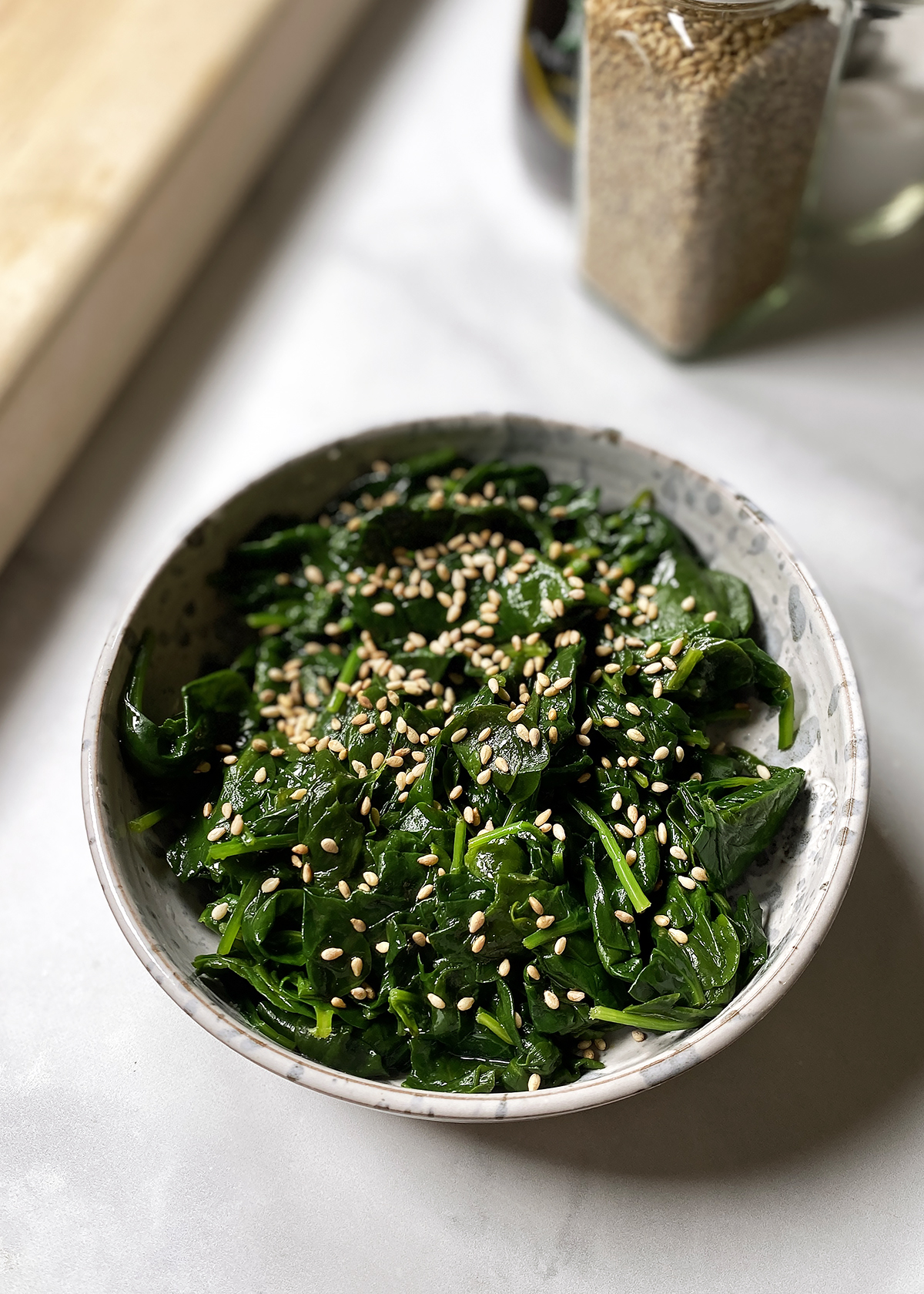
Repeat process for spinach, which will blanch in about 3 minutes. Toss with Toss with ½ teaspoon salt and 1 teaspoon sesame oil.

Rinse cucumbers to remove salt and liquid. Squeeze out excess liquid. Toss with ½ teaspoon sesame oil and ¼ teaspoon gochugaru, Korean chile powder, if using.
Assemble Salmon Bibimbap Bowls

Fry eggs sunny side up.

When ready to serve and eat, place 1 cup of steamed rice in the center of each serving bowl. Arrange ¼ to ⅓ cup each of prepared and fresh vegetables around the rice.

Place cooked salmon over rice and vegetables. Add fried egg on top.

Dollop about 2 tablespoons of Bibimbap Sauce onto each bowl. Garnish with toasted sesame seeds. Serve extra Bibimbap Sauce on the side at the table.

Pro-tip to Make it a Party: We call it a DIY Bibim-Bar! Prepare each of the individual ingredients in large batches including the salmon, set them out in the individual serving bowls and platters like a buffet. Give each person a bowl with rice in it, then let them build their own Bibimbap Bowl!
What Kind of Salmon is Best for Salmon Bibimbap?
This recipe for Salmon Bibimbap has directions for fresh salmon, but you can re-heat a piece of leftover salmon from the night before, and even canned salmon or lightly hot-smoked salmon!
Because the salmon flakes apart and breaks up as it mixes into the rice, and there are so many layers of flavor, and some pretty intense heat and umami from the gochujang-based Bibimbap Sauce, you don't notice the flavor of the salmon on its own anyway.
On busy weeknights, I make Salmon Bibimbap with canned wild salmon (this brand, in particular)! Use whatever salmon is most accessible for you and won't be the limiting factor for you to make and Salmon Bibimbap.
It doesn't matter what type of salmon either—Atlantic, Coho, King, Sockeye—though my preference is for wild King salmon or sockeye salmon. King salmon is fattier, making it a little more omega-3-rich. Deep red-hued sockeye salmon is leaner and has a fuller flavor, so it can stand up to the spice and strong flavors of the gochujang sauce.

Ingredients Notes and Resources
- Brown Rice. Rice used for Bibimbap is almost always short-grain white rice. But in my home kitchen, I use a short- or medium-grain brown rice for the fiber boost. If you have access to a Japanese grocery store, look for rice from Koda Farms, which is a multi-generational Japanese rice farming family in California who grows the best rice.
- Salt. I use this brand of Kosher salt.
- Rice Vinegar. I use this organic rice vinegar. If you can't find rice vinegar, apple cider vinegar is a good substitute.
- Sesame Oil. Look for toasted sesame oil, which is darker in color and has a deep umami flavor. Sesame oil is a finishing oil, added to dishes in small amounts just before serving for its flavor, rather than a cooking oil. This is a reliable Japanese brand that I've been using since I was a kid.
- Gochugaru. Gochugaru is a medium-spicy Korean chili flake or chili powder made from sun-dried chilis. This is the organic brand I use, available online. I have never seen organic gochugaru in a Korean grocery store. If you can't find gochugaru, you can substitute cayenne pepper or paprika.
- Toasted Sesame Seeds. You can buy sesame seeds plain or toasted. Make sure the seeds are toasted. If they are not toasted, toss them in a hot, dry skillet over medium heat for about 90 seconds or until they are fragrant. To crush them, run through a spice grinder or a small blender. Crushing the sesame seeds releases more of their oils and fragrance into the food.
- All other fresh herbs and produce from either the Santa Monica Farmers' Market on Wednesday, or Whole Foods Market when I can't find what I need at the farmers' market.

Substitutions and Variations
Salmon Bibimbap is one of the most flexible recipes. Every single component can be substituted with something else to make the dish appropriate for your person taste, dietary needs, etc. Here are some suggested substitutions and variations, since I know you'll be making this every other day for the rest of your life.
- Rice. Use any kind of rice, grain, or even cauliflower rice that suits your taste or dietary needs. Quinoa is a great non-grain substitute, and if you really want to go for it, try crumbled tofu, or heck, just finely chopped lettuce. Yes, lettuce sort of changes the dynamic of the whole "bap"="rice" thing, but don't let that hold you back from getting all those other good ingredients into your bowl.
- Other Fish for Salmon. I make this recipe as a way to eat salmon at least 3 times a week, but if there's a fish you love like cod, halibut, tuna, cook it simply and use it in your Bibimbap bowl.
- Canned Fish. As mentioned above, you can even use canned fish to make Salmon Bibimbap super fast, easy, and convenient for a weeknight.
- Any Other Vegetables. Literally, substitute in any other vegetables you love. In fact, bibimbap is a GREAT way to finish any and all the vegetables you need to use up in your refrigerator. Broccoli? Chop, drop and season. Kale? Cook it like the spinach. Lettuce? Shred it and add it to the bowl. Sweet potatoes? Julienne and cook them like carrots. The one thing to keep in mind though, is to go for a variety of color, and a mix of fresh/raw, pickled, and cooked.
- Leftover Vegetables. If you have leftover cooked vegetables like Roasted Broccoli, Brussels sprouts, or anything, chop or shred and throw 'em in.
Cast Iron Skillet. If you're a fan of the crunchy, toasted, near-burnt rice in the bottom of the stone pot for a type of bibimbap called Dolsot Bibimbap, you can serve this Salmon Bibimbap the same way using a cast iron skillet.
Pro Tips and Techniques for Salmon Bibimbap
- On salmon serving sizes: For Salmon Bibimbap, estimate 4 ounces of salmon per serving, which is about half the amount of salmon I usually allot—6-8 ounces or half a pound—when salmon is the primary main dish. Because Bibimbap is more about the rice, you will need less salmon.
- Cook Rice with Least Amount of Water. Make sure to cook rice with the exact amount of water so it's not too "soggy." Slightly drier rice make for better bibibmap because all the additional ingredients can add moisture, especially the gochujang-based Bibimbap Sauce. Rice cookers these days are pretty good about cooking rice "perfectly" even if you add slightly more or less water, but if you cook rice on the stovetop, let it cook a little longer, or let it "dry out" after it's done cooking by leaving the lid off for the steam to blow off.
- Advance Cooking. You can make almost all the ingredients in advance. In fact, you absolutely should make them in advance in bulk as "meal prep" for the week! The advance prepped ingredients will keep in the refrigerator in individual sealed containers for 1-3 days, based on the Advance Prep Guidelines below.
Tools and Equipment
As I always say, you don't need any special equipment to make almost any recipe. However, that's not to say there are a couple of gadgets and tools that might make it a LOT easier to get Salmon Bibimbap from your fridge to fork, or spoon.
- Rice cooker
- Heavy bottom pot if you cook rice or grains on the stovetop.
- Colander/sieve
- Fish spatula
- Extra large cutting board
- Mandoline
- Chef's knife
- Individual bowls
- Squeeze bottle for Bibimbap Sauce if you don't have empty, washed out sriracha bottles
- Mini ¼-cup liquid measuring cup
- Glass mixing bowls for prepped vegetables
- Glass storage container with airtight lids, perfect size for storing advance cooked ingredients, leftovers, and Bibimbap Sauce
** Pro-tip: Save your empty sriracha hot sauce bottles after you're done to use for Bibimbap Sauce! When you make Bibimbap Sauce, pour it into an empty, clean sriracha bottle and you can squeeze the sauce directly over your bibimbap bowls just like they do at OG Korean restaurants!
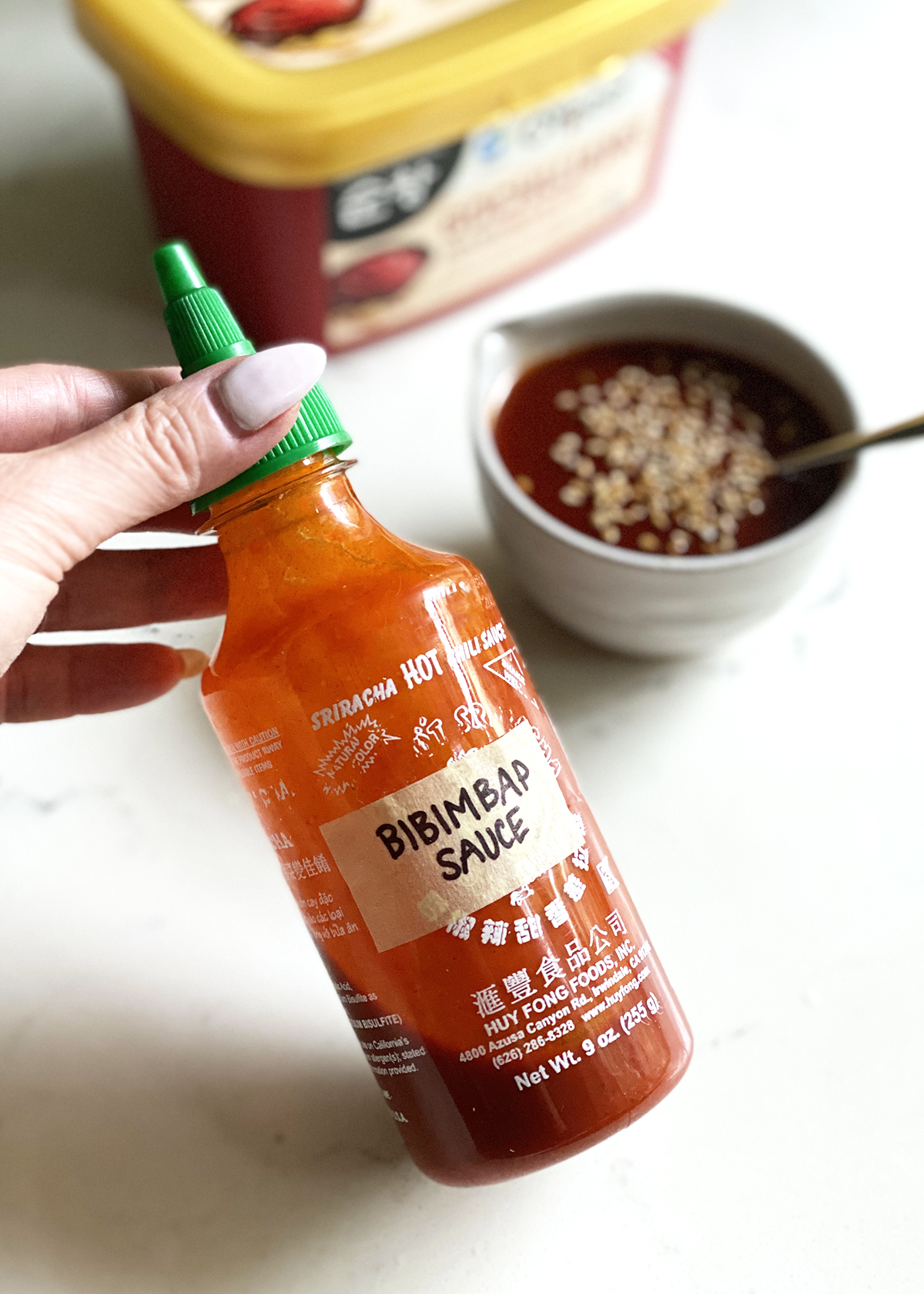
Advance Prep, Leftovers, and Storage
Advance Preparation
You can prep all of the ingredients in advance and store them separately in air-tight containers in the refrigerator prior to serving. Here's how far in advance you can prep the individual ingredients and keep in the refrigerator:
- Bibimbap Sauce: prep up to two weeks (14 days) in advance
- Steamed rice: up to 3 days in advance, though rice
- Vegetables except sprouts and spinach: up to 3 days in advance
- Sprouts and Spinach: 1 day in advance
- Salmon: 1 day in advance
Leftovers Storage
Refrigerating Leftovers. Use the above time guidelines for storage of leftovers of individual ingredients in the refrigerator if you cook on the same day you eat.
Once the Salmon Bibimbap has been served and mixed together, it will keep in the refrigerator in an airtight container for one day.
Freeze Leftovers. Steamed rice and cooked salmon will keep in the freezer in airtight containers for up to 1 month.
The prepared vegetables can keep in the freezer, but but it is not recommended because their textures will change significantly.
You can freeze Bibimbap Sauce for up to 6 months in an air-tight container with as much air removed. Thaw in the refrigerator. Microwave thawing is not recommended. Stir the thawed sauce to re-combine the ingredients before serving.
What Else to Serve with Salmon Bibimbap
An enormous bowl overflowing with omega-3-rich salmon, a rainbow of antioxidant-rich vegetables, mixed with a metabolism-firing hot sauce is already an entire meal! But if you like to have a little side of either something cold and refreshing or hot and brothy to wash it all down, try these:
- Bone broth
- Miso soup
- Pile of kimchi is always a given, and can be chopped and mixed right into the bibimbap, too
- Tiny bowls of interesting banchan that's not already in the Bibimbap
- Gim, Korean toasted nori squares to wrap up the mixed Salmon Bibimbap
FAQ
If I did my job writing this post, all of your questions should have already been answered, but here are a few all in one place. And if any additional questions come up while you make this Salmon Bibimbap, drop them in the comments!
Bibimbap is a traditional Korean dish that consists of a bowl of steamed rice topped with a colorful assortment of fresh, pickled, and cooked vegetables, usually some kind of protein like tofu, beef, and in this case salmon, sometimes a fried egg, and hot sauce. All of the components of bibimbap are arranged carefully by color to serve, then mixed together in the bowl right before eating. "Bibimbap" translates literally from Korean "bibim" + "bap" to English as "mixed" + "rice."
One serving of Salmon Bibimbap as presented in this recipe has: 624 calories, 37 g protein, 21 g fat, and 7 grams of fiber. As always, these are estimates based on the recipe and nutritional data provided by the USDA.
Salmon Bibimbap is not a traditional traditional Korean dish.
Bibimbap Sauce, made with gochujang, Korean hot pepper paste, plus a few other ingredients is my personal favorite. However, you can also use gochujang, Korean hot pepper paste, straight out of the container as your sauce.
If you don't have gochujang handy, try sriracha, which is a Southeast Asian hot sauce with a higher-toned, vinegar-forward flavor. Alone, sriracha tastes very different from gochujang, which has a deeper-toned, earthy umami flavor. If you have access to miso paste, combine 1:1 with the sriracha to mimic the umami in gochujang. Chili crunch or chili oil will also work. In an absolute pinch, use any hot sauce!

Salmon Bibimbap Recipe
Ingredients
- 4 4-6 ounce pieces of salmon
- 2 cups rice approximately 5 cups cooked
- 2 cups bean sprouts
- 2 carrots julienned
- 4 Persian cucumbers thinly sliced
- 2 cups julienned radish
- 10 ounces spinach
- 2 large zucchini julienned
- sea salt
- sesame oil
- rice vinegar
- toasted sesame seeds
- optional: 1 teaspoon gochugaru Korean red pepper flakes
- 4 eggs fried sunny-side up
- ½ cup Bibimbap Sauce or gochujang plus more to serve at the table
Instructions
Cook Rice
- Rinse rice under running cold water until water runs clear, then steam in rice cooker as per manufacturer's instructions, or cook on stovetop.
Cook Salmon
- If cooking salmon from fresh, pat salmon dry with paper towels. Season filets on both side with salt.
- Cook salmon via your preferred method. To sear salmon quickly on the stove top, heat frying pan over medium heat, add oil, then sear salmon on both sides until just cooked through, about 3 minutes on each. Total cooking time depends on how thick the salmon filets are. Remove salmon from pan and set aside on a plate to cool.
Prepare Vegetables
- Bring a large pot of water to boil.
- Sprinkle sliced cucumbers with salt, gently toss, then set aside to draw water out of the cucumbers while you prepare the remaining vegetables.
- Ladle ¼ cup of the boiling water from the pot over the julienned radish in a small bowl or glass jar. Add 2 tablespoons rice vinegar and 1 teaspoon salt. Stir to dissolve salt, and let radish "pickle" while you prep the rest of the ingredients.
- Drop bean sprouts into boiling water. Return water to a boil, then turn down to a simmer. Blanch the sprouts until they are just beginning to wilt, about 10 minutes. Remove the sprouts from the pot with tongs, large slotted spoon, or small colander. Drain off or squeeze as much water from the sprouts as possible. Toss with ½ teaspoon salt, 1 teaspoon sesame oil, and 1 teaspoon crushed toasted sesame seeds (optional). Set aside.
- Drop zucchini into the same boiling water and blanch to just before they begin to wilt, about 5 minutes. Remove zucchini from the pot with large slotted spoon or small colander. Gently shake the zucchini to drain off as much water from the zucchini as possible, and set aside in a small bowl. Toss with ½ teaspoon salt and 1 teaspoon sesame oil.
- Continue the same method of drop-blanch-remove-drain for the julienned carrots. Carrots will take about 10 minutes to soften. Toss with ½ teaspoon salt and 1 teaspoon sesame oil.
- Repeat process for spinach, which will blanch in about 3 minutes. Toss with Toss with ½ teaspoon salt and 1 teaspoon sesame oil.
- Rinse cucumbers to remove salt and liquid. Squeeze out excess liquid. Toss with ½ teaspoon sesame oil and ¼ teaspoon gochugaru, Korean chile powder, if using.
Assemble Salmon Bibimbap Bowls
- Fry eggs sunny side up.
- When ready to serve and eat, place 1 cup of steamed rice in the center of each serving bowl. Arrange prepared and fresh vegetables around the rice.
- Place cooked salmon over rice and vegetables. Place fried egg on top.
- Dollop about 2 tablespoons of Bibimbap Sauce onto each bowl. Garnish with toasted sesame seeds. Serve extra Bibimbap Sauce on the side at the table.


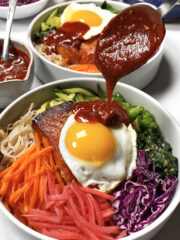
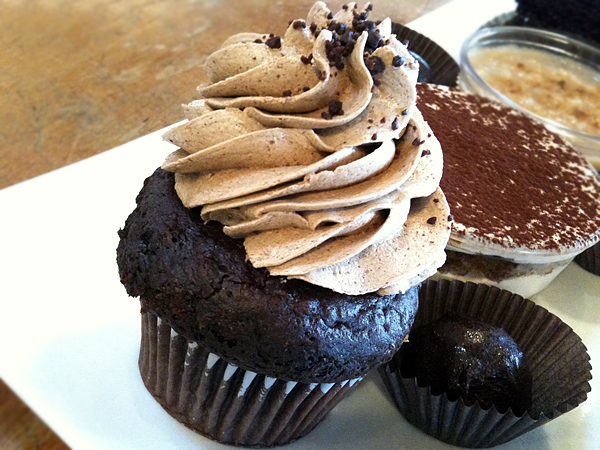

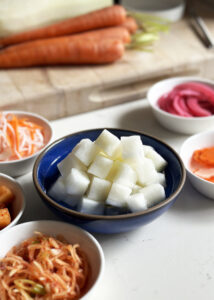

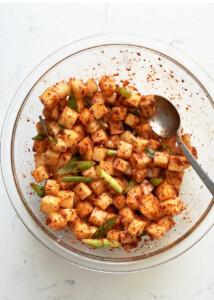

Laurie Baker says
This is the best Salmon Bibimbap recipe I've ever seen and it's so easy to make.